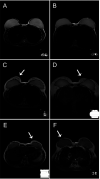Inter- and intra-observer agreement on evaluating the presence of residual glandular tissue with magnetic resonance tomography following prophylactic mastectomy
- PMID: 34851154
- PMCID: PMC9780752
- DOI: 10.1177/02841851211058929
Inter- and intra-observer agreement on evaluating the presence of residual glandular tissue with magnetic resonance tomography following prophylactic mastectomy
Abstract
Background: There are no published international consensus or guideline documents regarding appropriate medical follow-up for women with hereditary increased risk of breast cancer who opt for prophylactic mastectomy. Moreover, it is not known whether breast magnetic resonance imaging (MRI) performed after a prophylactic mastectomy is a reproducible method for evaluating whether clinically relevant amounts of residual glandular tissue remains.
Purpose: To evaluate the inter- and intra-observer agreement on detecting residual glandular tissue with MRI.
Material and methods: In total, 40 women previously operated with prophylactic mastectomy underwent MRI and two breast radiologists (R1 and R2) independently assessed the presence of residual glandular tissue. Inter- and intra-rater agreements were assessed using Cohen's kappa (k).
Results: Residual glandular tissue was found in 69 of 248 quadrants (27.8%) and 32 of 62 breasts (51.6%) by R1 and 77 of 248 quadrants (31.1%) and 35 of 62 breasts (56.5%) by R2. The interrater agreement was observed to be moderate (k = 0.554) and the intra-rater agreement was observed to be substantial (k = 0.623).
Conclusion: In conclusion, the inter-and intra-rater observer agreement in regard to detection of residual glandular tissue was not excellent, which would be desirable for a method considered reproducible enough to be used as a surveillance tool after the surgical procedure in order to ensure that there is no relevant residual glandular tissue remaining warranting further follow-up. More research is needed, as well as establishment of precise protocols, before using the method in risk assessment of remaining glandular tissue and breast cancer risk.
Keywords: Prophylactic mastectomy; magnetic resonance tomography; residual glandular tissue.
Conflict of interest statement
The author(s) declared no potential conflicts of interest with respect to the research, authorship, and/or publication of this article.
Figures

Similar articles
-
Prophylactic mastectomy - Correlation between skin flap thickness and residual glandular tissue evaluated postoperatively by imaging.J Plast Reconstr Aesthet Surg. 2022 Jun;75(6):1813-1819. doi: 10.1016/j.bjps.2022.01.031. Epub 2022 Jan 23. J Plast Reconstr Aesthet Surg. 2022. PMID: 35177362
-
Inter- and intra-observer agreement of BI-RADS-based subjective visual estimation of amount of fibroglandular breast tissue with magnetic resonance imaging: comparison to automated quantitative assessment.Eur Radiol. 2016 Nov;26(11):3917-3922. doi: 10.1007/s00330-016-4274-x. Epub 2016 Apr 23. Eur Radiol. 2016. PMID: 27108300 Free PMC article.
-
Residual glandular tissue (RGT) in BRCA1/2 germline mutation carriers with unilateral and bilateral prophylactic mastectomies.Surg Oncol. 2019 Jun;29:126-133. doi: 10.1016/j.suronc.2019.04.009. Epub 2019 May 3. Surg Oncol. 2019. PMID: 31196476
-
Residual Glandular Breast Tissue After Mastectomy: A Systematic Review.Ann Surg Oncol. 2020 Jul;27(7):2288-2296. doi: 10.1245/s10434-020-08516-4. Epub 2020 May 10. Ann Surg Oncol. 2020. PMID: 32390098
-
Oncological safety of prophylactic breast surgery: skin-sparing and nipple-sparing versus total mastectomy.Gland Surg. 2015 Dec;4(6):467-75. doi: 10.3978/j.issn.2227-684X.2015.02.01. Gland Surg. 2015. PMID: 26645001 Free PMC article. Review.
Cited by
-
Risk factors for residual fibroglandular breast tissue following a mastectomy - an overview and retrospective cohort study.BMC Cancer. 2024 Jul 18;24(1):856. doi: 10.1186/s12885-024-12491-4. BMC Cancer. 2024. PMID: 39026150 Free PMC article.
References
-
- Bröstcancer - Nationellt vårdprogram. In: samverkan RCi ed. 2020.
-
- Kuchenbaecker KB, Hopper JL, Barnes DR, et al. Risks of breast, ovarian, and contralateral breast cancer for BRCA1 and BRCA2 mutation carriers. JAMA 2017;317:2402–2416. - PubMed
-
- King MC, Marks JH, Mandell JB, et al. Breast and ovarian cancer risks due to inherited mutations in BRCA1 and BRCA2. Science 2003;302:643–646. - PubMed
MeSH terms
LinkOut - more resources
Full Text Sources
Medical

